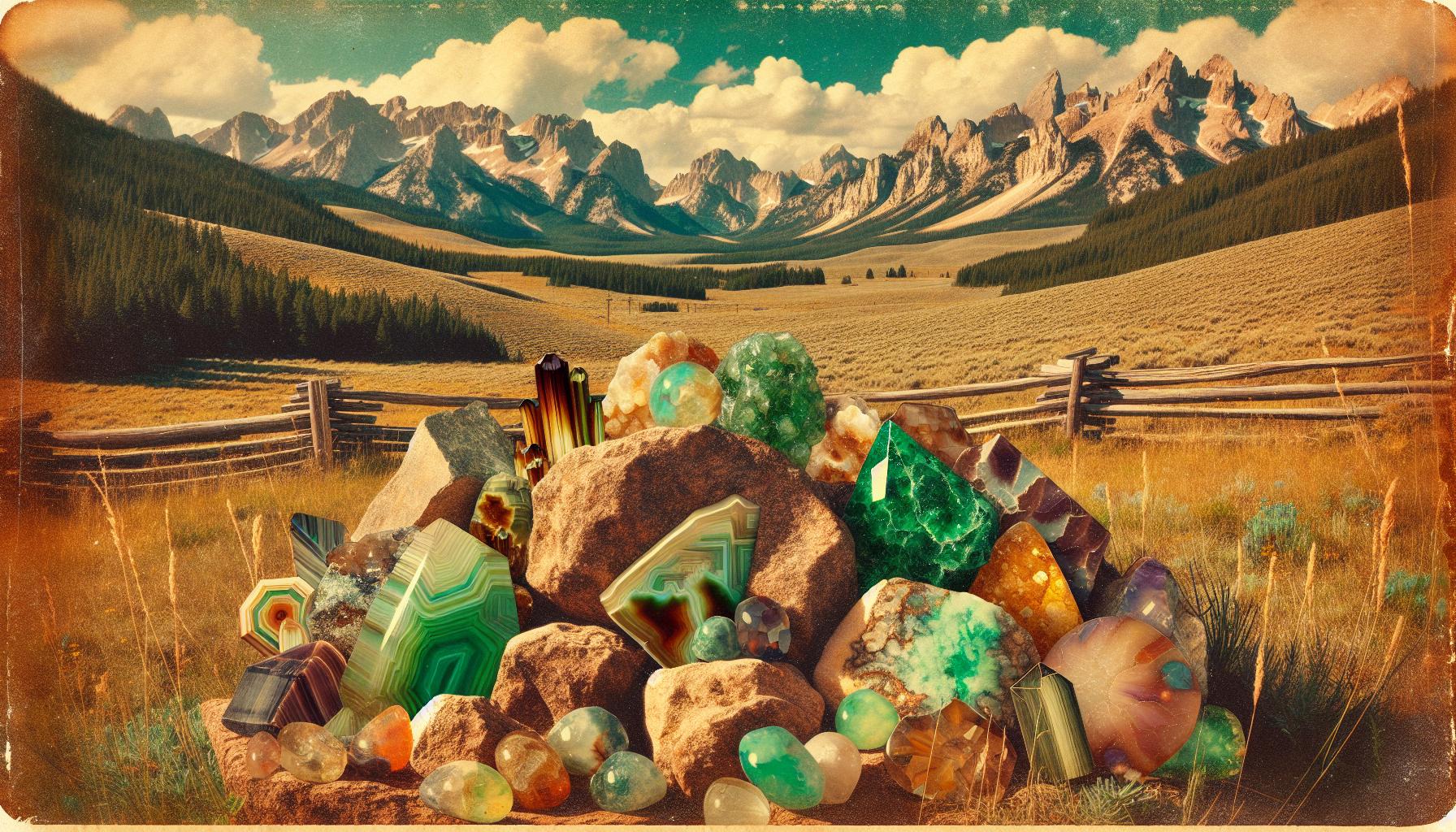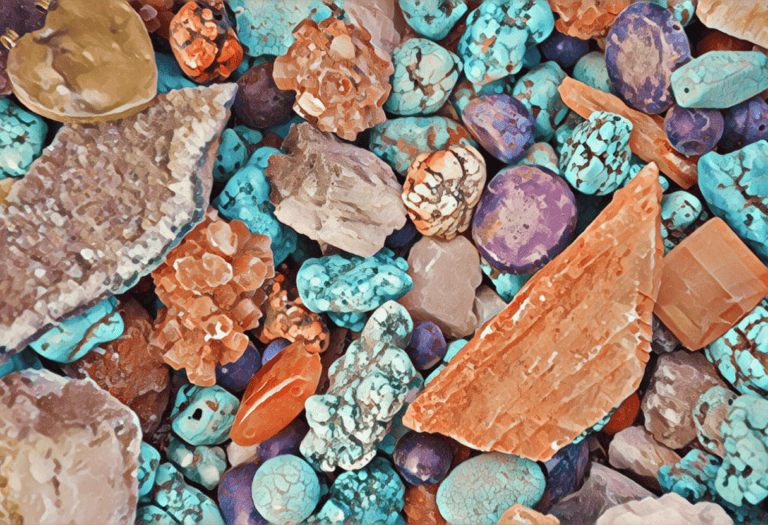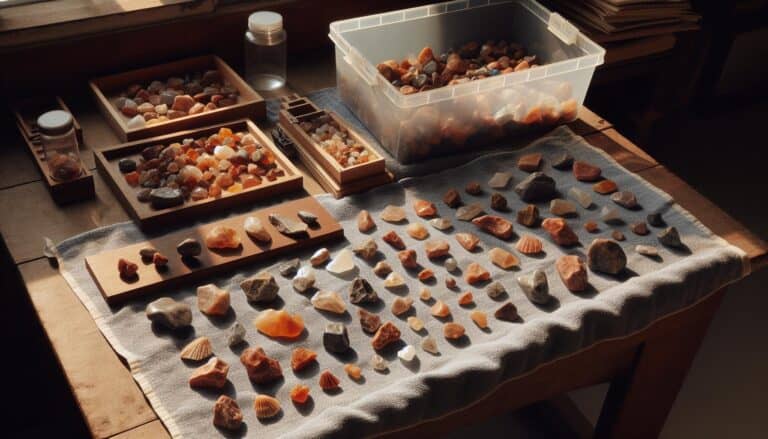Wyoming’s rugged landscapes are a rockhound’s paradise, rich with geological treasures just waiting to be unearthed.
From the windswept plains to the towering peaks, you’re in for a real adventure as you explore the state’s abundant rockhounding sites.
You’ll discover a variety of minerals, gemstones, and fossils that tell tales of Earth’s ancient past. Whether you’re searching for the vibrant red of jasper, the elusive gleam of gold, or the prehistoric allure of fossils, Wyoming’s diverse terrain has something to offer every enthusiast.
Prepare to embark on a journey through the Cowboy State’s hidden nooks and crannies where the earth’s secrets lie in wait.
Get ready to fill your pockets with wonders as you find out where to rockhound in Wyoming and what incredible finds you can expect.
Wyoming’s diverse landscapes are rich in rockhounding opportunities, with notable sites including Yellowstone National Park for minerals, Pryor Mountains for agate and jasper, Fossil Butte for fossils, Rattlesnake Hills for gold, and Copper Mountain for malachite and azurite.
Wyoming Rockhounding Locations
When you’re setting out for a rockhounding adventure in Wyoming, knowing where to look is half the battle. You’ll find numerous locations across the state that are rich in geologic treasures. Starting in the northwest corner, Yellowstone National Park offers areas where rockhounding is allowed, although it’s essential to check current park regulations as some areas may be off-limits.
As you move south, don’t miss the Pryor Mountains, which are known for beautiful specimens of agate and jasper. Pryor Mountain is not just a haven for rockhounds but also a stunning locale that provides a picturesque backdrop to your treasure hunting.
For those intrigued by paleontology, the Fossil Butte National Monument is a must-visit. Here, you can find exceptionally well-preserved fish fossils, with public collecting sites nearby that offer similar finds.
Central Wyoming Treasures
Central Wyoming is rich in minerals. The Rattlesnake Hills, near Casper, are famous for their gold deposits. While the chance of striking it rich might be slim, there’s definitely fun in panning for flakes and nuggets in this history-rich region.
Not far from there, at Copper Mountain, rockhounds often unearth malachite and azurite. The areas around the defunct copper mines are particularly noted for these beautiful blue and green minerals.
A short journey to the southwestern part of the state, and you’ll reach the renowned Eden Valley. This area is celebrated for yielding fossilized wood; some pieces are so well-preserved that they closely resemble the wood’s initial appearance millions of years ago.
- Highlights in Eastern Wyoming:
- Glendo Reservoir: perfect for finding agate and petrified wood.
- Medicine Bow Mountains: offering quartz crystals and aquamarine.
Each of these locations boasts unique geological formations and the potential for spectacular finds. Prepare to dust off your rock hammer and embrace the thrill of discovery as you scour the terrain of Wyoming for its hidden geological wonders.
What Gemstones are Found in Wyoming?

Venturing into Wyoming, you’re stepping into one of the richest terrains for rockhounding. Numerous sites offer a dazzling array of gemstones that will tantalize both novice and experienced collectors alike. Here’s what you might discover on your rockhounding adventure.
Jade is one of Wyoming’s most famous offerings. The state is known for its high-quality nephrite jade, which can be found in various locations, including the Granite Mountains and Wind River Range. This lustrous green gemstone has been crafted into tools and ornamental objects by humans for thousands of years.
In the hunt for something sparkling? Diamonds have also graced Wyoming’s landscape, with the state boasting a state park named after these precious stones – the Wyoming Diamond State Park near Kelsey Lake. Though not as abundant as in other regions, the thrill of finding a diamond in the rough here is unmatchable.
Agates and jaspers are abundant and come in a splendid variety of colors and patterns. These collectibles are often found in riverbeds and gravel deposits. For example, the gravels of the Wind River contain agates that radiate with fiery hues, while jaspers can be located in the Green River Basin.
Turquoise and opals can be unearthed in Wyoming as well, with the Big Horn Mountains being a notable hotspot. Though less common than other gemstones, the thrill of finding even a small piece can be the highlight of any rockhound’s trip.
Wyoming’s diverse geological features don’t just provide a scenic backdrop for outdoor activities but also a treasure trove for gemstone enthusiasts. Remember that each location has its own regulations regarding rockhounding—always confirm what’s allowed before you start your search.
Not only does the landscape hold an impressive variety of stones, but the history and cultural significance of these gems are embedded in the rich soil of Wyoming. Whether you’re looking to add to your collection or simply seeking an adventure, understanding what’s beneath your feet can transform your rockhounding expedition into an unforgettable journey.
What Sedimentary Rocks You Can Find in Wyoming?

When you’re embarking on a rockhounding adventure in Wyoming, you’ll be thrilled to find that the state is a treasure trove of sedimentary rocks. These rocks, which form from the accumulation of sediments over time, paint a vivid picture of the area’s ancient environments.
Fossils are a key feature of Wyoming’s sedimentary rock layers. In places like the Green River Formation, you can discover an astounding variety of fossilized fish and plants that transport you back to prehistoric lakes and waterways.
Sandstone and limestone, created from compacted sand and calcium carbonate respectively, abound in the Bighorn Basin. Not only do these rocks provide insight into the ancient seabeds and deserts, but they also possess a natural beauty that collectors and enthusiasts appreciate.
As you meander through the badlands of Wyoming, keep an eye out for shale. This fine-grained sedimentary rock, often overlooked for its muted appearance, carries remnants of clay and silt from old river deltas and floodplains.
Here’s a quick rundown of where you can find these sedimentary treasures:
- Fossils: Green River Formation
- Sandstone: Bighorn Basin and Red Desert
- Limestone: Medicine Bow Mountains
- Shale: Powder River Basin
Remember, rockhounding isn’t only about the thrill of discovery; it’s about connecting with Earth’s past. As you hunt for these sedimentary gems, you’re treading on the very pages of our planet’s deep history.
Tips for Identifying Sedimentary Rocks
To maximize your rockhounding experience, it’s essential to know how to identify sedimentary rocks. Look for layers or strata, which are typical of these types of rocks. Sedimentary specimens often have a rough texture and may contain visible fossils, shells, or other organic materials. Be sure to bring along a field guide and take note of the rock’s grain size and composition, as these can provide valuable clues about its origin.
What Metamorphic Rocks are found in Wyoming?
Wyoming’s geological treasure chest is not limited to sedimentary rocks and fossils; it also includes metamorphic rocks, which have undergone transformation due to intense heat and pressure. As you explore Wyoming’s landscape, you’ll find that these rocks tell a story of a deep and dynamic Earth.
Schist and gneiss are prominent metamorphic rocks in the region. They’re typically found in the cores of mountain ranges such as the Laramie, Beartooth, and Bighorn Mountains. These rocks often feature beautiful banding and twinkling minerals that can add a unique aspect to your collection.
In the Laramie Range, you’ll encounter the Sherman Granite, an aesthetically striking rock. Although primarily igneous, this granite has experienced metamorphism, giving rise to its distinctive texture and appearance. Here’s a breakdown of notable metamorphic rocks you may find:
- Schist
- Gneiss
- Quartzite
- Marble
- Slate
Another point of interest is the potential to find gem-quality stones within these metamorphic rocks. Wyoming is known for harboring hidden treasures like jade, which is highly sought after by both hobbyists and professional collectors. Don’t overlook quartzite outcrops either; they might house beautiful quartz crystals.
When identifying metamorphic rocks, look for signs of transformation like foliation – the layering within the rocks – and recrystallized minerals. These features are indicative of the tremendous pressures and temperatures that crafted them deep within the Earth.
In your rockhounding adventure, always remember to respect the land. Stick to public areas or obtain permission before entering private land, and adhere to the Leave No Trace principles to protect these natural wonders for generations to come.
What Igneous Rocks can You Find in Wyoming?
Wyoming’s geological treasure chest isn’t limited to just metamorphic rocks. Igneous rocks, formed from the cooling and solidification of magma or lava, are abundant and have made their own mark on the state’s rockhounding scene. When you’re exploring Wyoming’s varied landscapes, you’re likely to come across a few igneous rock types that stand out for their beauty and geological significance.
Granite is undoubtedly the most common igneous rock you’ll encounter in Wyoming. This coarse-grained rock consists mainly of quartz and feldspar, with a sprinkle of mica, amphiboles, and other minerals. The Granite Mountains and Teton Range are prime examples of where this durable rock is found in the state. Granite not only forms some of the most striking natural landscapes in Wyoming but can also be a source of beautiful mineral specimens.
On the other side of the spectrum lies basalt, a fine-grained igneous rock that forms from quick-cooling lava. You’ll find basalt primarily in ancient lava flows present within the state. Due to its rapid cooling, basalt often contains small crystals and can sometimes capture gas bubbles that were trapped during the solidification process, leading to unique formations within the rock.
Unearth Gemstones in Igneous Rocks
The hunt for gemstones nestled in igneous rocks adds an exciting twist to your rockhounding adventure. Here’s what you might find:
- Obsidian: Often referred to as volcanic glass, obsidian is a glossy and usually black igneous rock, prized for its sharp edges and striking appearance. Watch out for obsidian while exploring regions with past volcanic activity.
- Agate: While journeying through the Wyoming landscape, keep an eye out for agate, a semi-precious gemstone with distinctive banding patterns. Agates can be found in a range of colors and are often recovered from igneous rocks like rhyolite.
With the right tools and a keen eye, your rockhounding efforts in Wyoming can reward you with exceptional igneous rock specimens. Remember to always check land ownership and permissions before collecting, as some areas may have restrictions to ensure the conservation of these natural resources.
Panning for Gold in Wyoming
Wyoming, the Cowboy State, isn’t just rich in stunning igneous rocks but also laden with streams that might bear gold. If you’re enticed by the glimmer of this precious metal, you’re in for a treat. Gold panning in Wyoming is a pastime that continues to capture the hearts of rockhounds and treasure seekers alike.
When dipping your pan into Wyoming’s waters, focus on areas known for past gold discoveries. The South Pass City and the streams around the Carissa Mine have a history with the gold rush. Their gravel beds may hide flakes or even nuggets that have been overlooked. Similarly, the Sweetwater River has been a hotspot for prospectors, and to this day, it holds potential for your panning adventures.
Here are some key spots to explore:
- Douglas Creek
- The Snake River
- Willis Creek
Don’t overlook the smaller tributaries and creeks; these could be untapped havens yielding fine gold particles. Moreover, public panning sites allow you to search without worrying about trespassing. It’s crucial, however, to always check for current claims and ensure you’re not infringing on someone’s right.
While panning, you’ll need patience and persistence. The process can be meticulous, requiring a keen eye and a soft touch. Fill your pan with sediment from the stream bed, then gently swirl the contents in the water. The gold, being heavy, will settle at the bottom, and with experience, you’ll learn to separate it from the other materials.
Remember, gold panning is about enjoying the process as much as the potential finds. Practice sustainable panning—avoid disturbing the ecosystem and return rocks where you found them. Keep your activities eco-friendly, ensuring that the beauty of Wyoming’s streams remains intact for future generations of rockhounds.
Rocks and Minerals Found in Wyoming
Wyoming’s geological diversity isn’t just a sight to behold; it’s a treasure chest for rockhounds like you. The state’s landscape is dotted with a vast array of rocks and minerals that can turn an ordinary hike into an exciting treasure hunt.
Jade is Wyoming’s state gemstone, and rightly so. You might find this beautiful green stone, revered in both art and jewelry, in the central part of the state, primarily around Jeffrey City. If you’re on the hunt for jade, remember it’s typically found in places where serpentine is plentiful.
Petrified wood is abundant throughout Wyoming, particularly in the Blue Forest area and Eden Valley. These ancient, fossilized forests offer a glimpse into prehistoric times and the organic minerals replaced by silica make them a rockhound’s delight.
On your excursions, keep an eye out for red jasper. This opaque, red rock is often associated with the iron oxide that colors the soil of Wyoming’s landscapes. Jasper is a variety of chalcedony, and finding a piece can be as rewarding as uncovering any precious stone.
Wyoming is also famous for its trona deposits, a source of sodium carbonate. The Green River Basin is home to the largest trona reserves in the world, and while the extraction is mostly industrial, small samples can sometimes be found around the mining areas.
| Mineral | Location | Notes |
|---|---|---|
| Jade | Central Wyoming | Near Jeffrey City, in serpentine-rich areas |
| Petrified Wood | Blue Forest, Eden Valley | Found in ancient, fossilized forests |
| Red Jasper | Statewide | Often found in iron oxide-rich soil |
| Trona | Green River Basin | Largest reserves in the world |
While exploring these areas, you’re bound to come across a range of other minerals and rock types. Quartz variants like smoky quartz and amethyst are also native to Wyoming’s mineral-rich grounds. Whether it’s in the shadows of the Big Horn Mountains or within the granite grips of the Laramie Range, quartz can manifest in stunning forms that are both aesthetically pleasing and scientifically significant.
Where Can I Find Fossils in Wyoming?
Wyoming is a treasure trove for fossil enthusiasts due to its rich geological history. Fossil Butte National Monument is a prime spot where you can explore and discover an array of ancient treasures. This venue is home to an exceptional concentration of Eocene Epoch fossils that are over 50 million years old. Here, you’re likely to encounter fossilized fish, insects, plants, and even the rare imprints of birds and reptiles preserved with incredible detail.
The Green River Formation, well-known for its detailed fish fossils, offers layers upon layers of history for you to uncover. These sedimentary rock formations, particularly around the Green River area, are a paleontologist’s dream, presenting conditions that were perfect for preserving the bio-indicators of ancient ecosystems. Look out for the Knightia fish, which is so commonly found here that it’s been named Wyoming’s state fossil.
In addition to these celebrated locations, the Morrison Formation exposes you to a different slice of prehistoric life. It’s infamous for its late Jurassic dinosaur fossils, including Allosaurus and Stegosaurus. While much of the Morrison Formation isn’t openly available for public digging, certain sections, especially near the Bighorn Basin, permit fossil hunting, providing you get the right permits.
For those inclined towards marine fossils, dive into Wyoming’s past at Warfield Fossil Quarries. Amid the high desert, you can find fossils from an ancient ocean, such as ammonites and fish. While there’s a fee to dig in these commercially operated quarries, the opportunity to find your own piece of marine history is well worth it.
Wyoming Rockhounding Laws & Regulations
When you’re ready to venture into Wyoming’s vast landscapes for rockhounding, it’s essential to understand the laws and regulations governing this activity. While Wyoming offers a plethora of opportunities for rock collectors, respecting land ownership and regulations is crucial for a lawful and enjoyable experience.
First, be aware that most land in Wyoming is privately owned, and you’ll need to obtain permission from the landowner before embarking on your rockhounding adventure. Without this permission, you’re trespassing, which can result in legal complications. Always secure consent in writing when possible to avoid misunderstandings.
Public lands such as National Forests and Bureau of Land Management (BLM) areas are open for rockhounding, but they come with their own set of rules. For the National Forests, you can collect a reasonable amount of specimens for personal use. However, for commercial purposes, a permit is required. The BLM allows casual rockhounding — collecting for personal use with hand tools and without mechanical excavation — but be sure to check for site-specific regulations before you start digging.
Here’s a quick overview of what’s permitted on public lands:
- Collecting small amounts of rocks, minerals, and semi-precious gemstones.
- The use of hand tools like picks, shovels, and metal detectors.
- Disturbances should be minimized, and any dug holes must be restored to their original state.
Remember that National Parks and Monuments have stricter rules with rock and fossil collection typically prohibited. Always check with local agencies or park officials if you’re unsure about the regulations of a specific area.
Fossil collecting on public lands carries its own legal framework. The Paleontological Resources Preservation Act protects significant paleontological sites, and collecting without a permit is illegal. Common invertebrate and plant fossils can be collected in small quantities on BLM land, but vertebrate fossils are off-limits.
Stay informed about the regulations of the area you plan to explore. Adhering to these rules not only ensures that you’re rockhounding legally but also helps preserve Wyoming’s natural heritage for future generations.
Rockhounding Tips for Beginners in Wyoming
Gearing Up: Essential Tools for Rockhounding
Before you start your journey into the world of rockhounding, you’ll need the right tools for the job. Essential equipment includes:
- Rock hammer: A sturdy hammer for chipping and breaking rocks.
- Chisels: Tools for prying rocks from the earth.
- Safety glasses: Protect your eyes from flying debris.
- Gloves: To keep your hands safe and clean.
- Bucket or bag: To carry your finds.
- Field guide: To help identify your discoveries.
Remember, investing in quality gear not only makes the hunt more enjoyable but also ensures your safety during the process.
Safety Tips While Rockhounding
Safety should always be your top priority. Keep these tips in mind:
- Stay hydrated: Wyoming’s climate can be harsh, so carry enough water.
- Wear proper footwear: Sturdy boots will help navigate rough terrain.
- Be aware of wildlife: Know how to respond if you encounter local fauna.
- Inform someone: Always let someone know where you’ll be hunting.
- Watch the weather: Abrupt changes can be dangerous, so monitor forecasts.
By being prepared and aware of your surroundings, you’ll ensure a safer rockhounding experience.
Legal Guidelines for Rockhounding Enthusiasts
Understanding the legal landscape in Wyoming is crucial. Here’s what you need to know:
- Permission: Always obtain permission before rockhounding on private land.
- Public lands: Know the regulations concerning collection on public lands.
- Fossils: Vertebrate fossils have special laws governing their collection.
- Do not trespass: Respect private property and stay on the right side of the law.
Adhering to legalities protects Wyoming’s geological heritage and allows everyone to enjoy rockhounding for years to come.
Conclusion: Wyoming Rockhounding Locations
Venturing into Wyoming’s vast landscapes, you’re now equipped with the knowledge to uncover its hidden geological treasures.
Remember, your rockhounding adventure isn’t just about the jade or the sparkling quartz variants you might find—it’s about respecting the land and its laws. With the right tools in hand and a mindful adherence to the guidelines, you’ll not only enjoy the thrill of the hunt but also contribute to preserving these natural wonders.
Embrace the experience, stay safe, and happy rockhounding!







